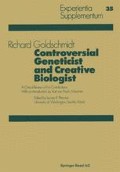Abstract
After a seminar in which I had discussed Richard Goldschmidt’s opposition to the chromosome theory of heredity, a colleague asked me if the history of twentieth century genetics might not have been better off had Goldschmidt never existed. Such a question underscores one of the vagaries of the history of science: a tendency to see events and people in terms only of progress toward the “right” idea. While it is true that Goldschmidt may be remembered by many biologists today more for the ways he was wrong than the ways he was right, such presentist views fail to see the complex interweavings which makes up the fabric of history. Despite the content of his theories (which are by and large rejected, in detail, by modern standards) Goldschmidt played an important role in the history of twentieth century genetics. Our understanding of, and approach to, genetic processes today bears the mark of the kinds of questions which Goldschmidt persisted in asking, often irreverently, throughout his entire career.
Access this chapter
Tax calculation will be finalised at checkout
Purchases are for personal use only
Preview
Unable to display preview. Download preview PDF.
References and Notes
Curt Stern, “Richard Benedict Goldschmidt, 1878–1958” Biographical Memoirs, National Academy of Sciences 39 (1967): 141–192; quotation p. 153–154..
The chromosomal arrangement in Lymantria is just the opposite for that in human beings, or Drosophila, in which males are XY, and females XX.
This summary is based on Goldschmidt’s The determination of sex, Nature 107 (1921): 780–784;
This summary is based on Goldschmidt’s The determination of sex, Curt Stern’s Genetic Mosaics and Other Essays ( Cambridge, Mass., Harvard University Press, 1968 ): p. 93.
Goldschmidt to Stern, July 8, 1942; Stern’s private correspondence; quoted with permission.
Author information
Authors and Affiliations
Editor information
Editors and Affiliations
Rights and permissions
Copyright information
© 1980 Springer Basel AG
About this chapter
Cite this chapter
Allen, G.E. (1980). The Historical Development of “Time Law of Intersexuality”and Its Philosophical Implications. In: Piternick, L.K. (eds) Controversial Geneticist and Creative Biologist. Experientia Supplementum, vol 35. Birkhäuser, Basel. https://doi.org/10.1007/978-3-0348-5855-7_7
Download citation
DOI: https://doi.org/10.1007/978-3-0348-5855-7_7
Publisher Name: Birkhäuser, Basel
Print ISBN: 978-3-0348-5857-1
Online ISBN: 978-3-0348-5855-7
eBook Packages: Springer Book Archive

